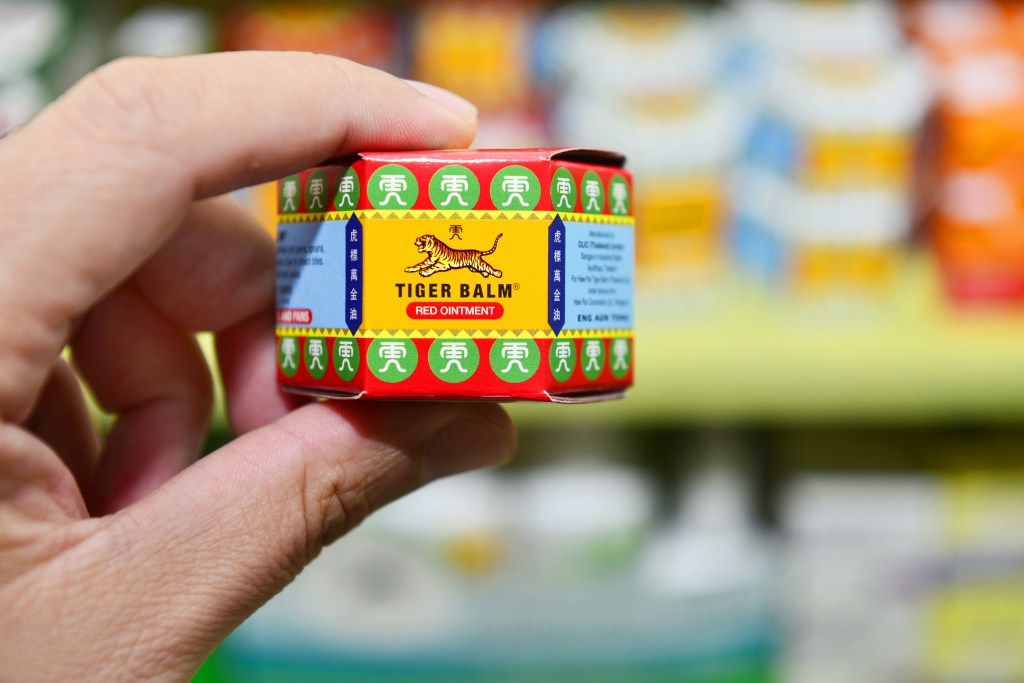Top Docs: Tiger Balm Is One of The Safest, Most Effective Forms of Pain Relief — and It Costs Just Pennies Per Use!
Plus, the doctor-approved storage secret that makes Tiger Balm twice as effective

Sometimes the old cures are the best cures, and that seems to be the case with Tiger Balm, which has been relieving pain for more than a century. What’s most astonishing about the topical pain-reliever is that it works in a way completely unlike non-steroidal anti-inflammatory drugs (NSAIDs) like Advil, and also quite unlike almost all the other topical pain relievers on the market. And this difference delivers unique benefits both in terms of speed and efficacy of pain relief, and as far as side effect go.
What is Tiger Balm?

Tiger Balm was formulated by a Chinese herbalist named Aw Chu Kin in the 1870s. And even though there are now a myriad of different formulations — including ointments, rubs, patches, liquids, sprays, and gels — available in drugstores and via online retailers, the ingredients haven’t changed much over time. Tiger Balm formulations typically include camphor, menthol, capsicum extract, methyl salicylate and essential oils like cassia, cajuput, clove and eucalyptus oil.
How does Tiger Balm compare to other pain medications?
Unlike anti-inflammatory products like the arthritis cream Voltaren and over-the-counter oral medications like ibuprofen, naproxen and aspirin, Tiger Balm is not an anti-inflammatory. “Tiger Balm “seems to work by having a counter-irritant effect on the nervous system,” explains Jeff Gross, MD, a clinical associate professor of rehabilitation medicine at the NYU Grossman School of Medicine. “It stimulates nerves in the skin, causing a cooling or warming effect, which masks the underlying pain from the deeper tissues in that part of the body.”
In a nutshell: the ingredients in the Tiger Balm work together to increase blood flow to the area on which it’s applied and create warm and cold sensations on the skin. This decreases the perception of pain in the area where the balm has been applied.
Because the brain can’t register both painful stimuli and sensations such as intense warmth or coolness at the same time, the sensations produced by the application of Tiger Balm essentially override the pain sensations from an underlying muscle strain or injury.
Does Tiger Balm actually change the temperature of the skin?
Yet, despite the warm and cool sensations it elicits, Tiger Balm doesn’t significantly change the actual temperature of the skin or the muscle that’s being targeted. “It just feels that way,” says Elizabeth Gardner, MD, an associate professor of orthopaedic surgery and rehabilitation at the Yale University School of Medicine. “But by blunting the sensitivity of these deeper pain receptors, there is less activation of these nerves, and thus muscles [that are] in spasm are relaxed, which also decreases pain sensations.”
Tiger Balm is often compared to another analgesic cream, Icy Hot. And while studies haven’t compared Tiger Balm and Icy Hot, the two brands do have similar ingredients. Some formulations of Icy Hot contain similar ingredients as Tiger Balm — namely, menthol and camphor — while others contain lidocaine, a topical anesthetic that eases pain by numbing the skin and surrounding tissue.
What is Tiger Balm used for?
There are many possible uses for the product, but it is most commonly used for chronic or acute musculoskeletal discomfort from arthritis; muscle strains and sprains; or neck, back or shoulder pain. “Tiger Balm can be effective to ease musculoskeletal aches and pain — this is exactly why it has been a staple in training rooms and locker rooms for years,” says Dr. Gardner. “For me, Tiger Balm and other topical analgesics are an important part of the multimodal approach to keeping athletes active and in the game. In my experience, most athletes would rather avoid pills, and thus these topical remedies are very appealing.”
Dr. Gross agrees: “The side effect rates are low with Tiger Balm. It’s safer than oral medications for muscle aches and pains.” An added perk: Using topical remedies like this can reduce your use of oral drugs that may have their own side effects, especially with frequent use.
Does Tiger Balm help in healing?
While using Tiger Balm can help relieve pain, “the chemical properties of Tiger Balm cannot penetrate deep enough into your muscles, joints or nerves to cause any substantial healing,” says Harrison Linder, MD, a pain management specialist with The Center for Interventional Pain Medicine at Mercy Medical Center in Baltimore, Maryland. In other words, it won’t cure an injury or condition underneath the skin.
“It is not going to fix severe arthritis, a pinched nerve or spinal stenosis — however, it can provide temporary relief by stimulating the nerves near your skin and blocking pain signals or distracting you from the pain signals long enough for your body to heal,” Dr. Linder adds. And temporary pain relief from injured muscles and inflamed tissues in a particular area may be valuable enough in some instances.
How effective is Tiger Balm?
There haven’t been many recent studies on the efficacy of Tiger Balm. But research has found that using it can temporarily ease muscle pain, and one study even found that it can relieve tension headaches. Meanwhile, a 2010 study found that people with mild to moderate muscle strains who used a patch containing methyl salicylate and menthol (two of the key ingredients in Tiger Balm) experienced a 40% reduction in their pain, compared to those who used a placebo patch.
The good news is: “Topical analgesics like Tiger Balm have an effect within minutes and can provide pain relief for a few hours,” says Sonali Khandelwal, MD, an associate professor of medicine at RUSH University Medical Center in Chicago.
Insider tip for making Tiger Balm twice as effective
You can double the pain-relieving power of Tiger Balm if you store in the fridge, recommends Jacob Teitelbaum, MD, an integrative medicine specialist based in Hawaii and author of Pain Free 1-2-3: A Proven Program for Eliminating Chronic Pain Now. “Pain signals and cold signals run on the same nerve fibers, kind of like a telephone line,” Dr. Teitelbaum explains. By using chilled Tiger Balm on a painful area, it may create a one-two punch to the pain signals in a way that provides faster and greater relief.
The safest way to use Tiger Balm
“Tiger balm should be used no more frequently than three to four times per day,” cautions Dr. Gardner. Using it more often can lead to skin irritation, such as redness, itchiness or a stinging or burning sensation. The expert consensus: When it’s used as directed, Tiger Balm is generally safe and well-tolerated.
One caveat: “Tiger Balm should not be used on irritated, sunburned and chapped skin, as the ingredients can cause further irritation,” Dr. Linder warns. It also shouldn’t be used on open wounds or damaged skin, and the manufacturer advises against using it before showering or bathing, and waiting 30 minutes after bathing to apply.
To be sure that Tiger Balm agrees with you, especially if you have sensitive skin, Dr. Gardner recommends testing it on a small area of your skin, such as the inside of your elbow, before applying it liberally.
“I advise people to wash their hands after applying it or to wear gloves while applying it so they don’t risk getting it into their eyes,” Dr. Khandelwal says. If that were to happen, you’d be trading one form of pain for another — which is the opposite of what you want!
This content is not a substitute for professional medical advice or diagnosis. Always consult your physician before pursuing any treatment plan.
















